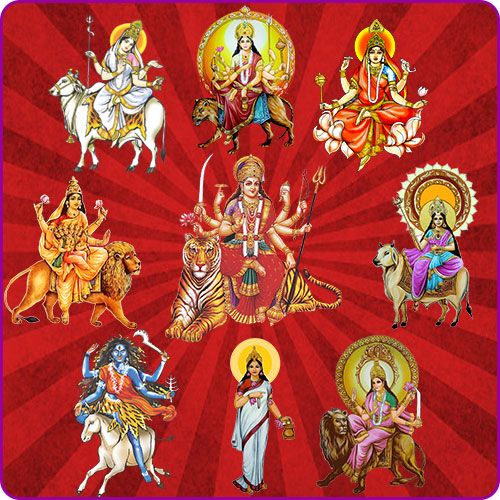Navrathri

Navratri is a nine-night Hindu festival that celebrates the goddess Durga and her various forms. It usually occurs in the lunar month of Ashvin, which typically falls between September and October in the Gregorian calendar. The festival symbolizes the victory of good over evil and is marked by vibrant celebrations, fasting, prayers, and cultural events.
### Key Aspects of Navratri:
1. **Deities Worshipped**: Each of the nine nights, one of the nine forms of Durga (Navadurga) is worshipped. The forms are:
- **Day 1**: Shailaputri (the daughter of the mountains)
- **Day 2**: Brahmacharini (the ascetic maiden)
- **Day 3**: Chandraghanta (the one who has a crescent moon on her forehead)
- **Day 4**: Kushmanda (the creator of the universe)
- **Day 5**: Skandamata (the mother of Skanda)
- **Day 6**: Katyayani (the warrior goddess)
- **Day 7**: Kalaratri (the fierce form of Durga)
- **Day 8**: Mahagauri (the goddess of purity)
- **Day 9**: Siddhidatri (the giver of accomplishments)
2. **Rituals and Worship**: Devotees typically engage in fasting and prayer, with elaborate rituals performed in homes and temples. Many people participate in "Aarti" (a devotional song) and "Havan" (fire rituals).
3. **Cultural Celebrations**: The latter part of Navratri, particularly in Gujarat, is known for Garba and Dandiya Raas, traditional folk dances that are enjoyed by people dressed in colorful attire. In some regions, people also prepare and perform plays and dramas depicting the stories of goddess Durga.
4. **Vijaya Dashami/Dussehra**: The festival culminates with Vijayadashami or Dussehra, which symbolizes the victory of Lord Rama over the demon king Ravana, and is celebrated with processions, the burning of effigies, and other festivities.
5. **Regional Variations**: The way Navratri is celebrated can vary significantly across different parts of India. In some regions, it may focus more on dance and music, while in others, it may be more centered on religious observance and prayer.
Navratri is a time for spiritual reflection, community bonding, and cultural expression, making it one of the most vibrant festivals in the Hindu calendar.
Navrathri is a significant festival in South India, and flowers play an essential role in the pooja (worship) rituals. Here are some of the flowers commonly used:
1. **Jasmine (Mallige or Mogra)**: Known for its lovely fragrance, jasmine is used to make garlands and offer to deities. It's also used in hair offerings and decorations.
2. **Marigold (Sembharuthi or Tagetes)**: Marigolds are vibrant and are used in garlands, decorations, and offerings. Their bright yellow and orange hues are considered auspicious.
3. **Hibiscus (Sembaruthi)**: This flower is often used in offerings, particularly to the goddess Durga. It is believed to be particularly sacred for goddess Kali and Lakshmi.
4. **Rose (Rosa)**: Roses are used for their beauty and fragrance. They can be offered in various colors, with red and pink being particularly common.
5. **Lotus (Padma)**: Although not always readily available, lotus flowers are considered highly sacred and are offered to deities, symbolizing purity and divine beauty.
6. **Oleandar (Arali)**: These flowers are used in decorations and offerings due to their vibrant colors and robust nature.
7. **Chrysanthemum (Sankhapushpam)**: Chrysanthemums are used in garlands and decorations. Their bright colors and variety make them a popular choice.
8. **Tuberose (Rajnigandha)**: Known for its strong fragrance, tuberose is used in making garlands and in various decorations.
In South Indian households, these flowers are often strung into garlands or used to decorate the altar and the surroundings of the pooja area. The choice of flowers might vary depending on regional practices and availability, but these are generally among the most common ones used during Navrathri celebrations.